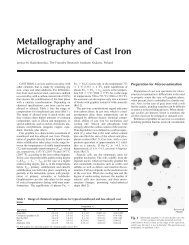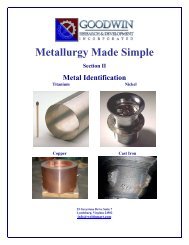Introduction Quantitative X-Ray Diffraction Methods Introduction ...
Introduction Quantitative X-Ray Diffraction Methods Introduction ...
Introduction Quantitative X-Ray Diffraction Methods Introduction ...
You also want an ePaper? Increase the reach of your titles
YUMPU automatically turns print PDFs into web optimized ePapers that Google loves.
<strong>Introduction</strong> <strong>Quantitative</strong> X-<strong>Ray</strong> <strong>Diffraction</strong> <strong>Methods</strong><br />
(prepared by James R. Connolly, for EPS400-001, <strong>Introduction</strong> to X-<strong>Ray</strong> Powder <strong>Diffraction</strong>, Spring 2010)<br />
Another significant problem in the use of integrated intensities is in overlapping peaks of<br />
interest and the difficulty of calculating integrated intensities. This requires one of two<br />
approaches: selection of peaks which do not overlap or decomposition of overlapping peaks<br />
into their components prior to calculating integrated intensities. The peak overlap situation is<br />
shown in Figure 13.5c below. Sophisticated digital tools for processing diffraction data<br />
make peak deconstruction or “deconvolution” possible.<br />
Useful tools in Jade to assist in processing Intensity Measurements<br />
The routine peak identification routine in Jade is useful for quick location of prominent peaks<br />
in a pattern, however the peak intensity determinations done by this routine are generally<br />
inadequate to intensity calculation required for quantitative analysis. Jade includes a number<br />
of processing tools which can assist in processing XRD patterns to obtain good reduced<br />
intensity data for software has several tools that are very effective in processing diffraction<br />
data to obtain background-corrected peak intensities for overlapping peaks. It should be<br />
noted that Jade does not alter the original data file when refining your data, but creates<br />
separate overlays that modify the data as used and displayed. Some of the useful intensityrelated<br />
tools are:<br />
Background and K 2 Removal (Flexible tool for removing background)<br />
Profile Fitting and Peak Decomposition (Interactive tool for differentiating and<br />
separating overlapping peaks)<br />
Crystallite Size and Strain Analysis from Peak Broadening (Tool used with standard<br />
materials – NIST 640b Si or LaB 6 – to establish instrumental broadening parameters<br />
and evaluate peak broadening from strain and crystallite size)<br />
<strong>Quantitative</strong> <strong>Methods</strong> based on Intensity Ratios<br />
Numerous methods have been developed to use peak intensities for quantitative analysis of<br />
diffraction data. Many of them are specialized in nature (i.e., require binary mixtures or<br />
(Material in this document is borrowed from many sources; all original material is ©2010 by James R. Connolly)<br />
(Revision date: 6-Apr-10) Page 6 of 14








